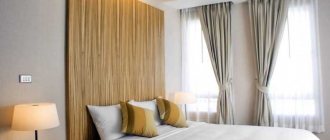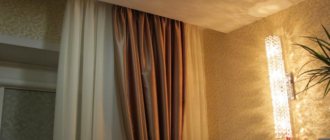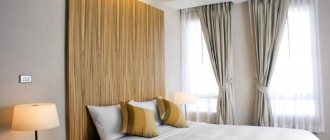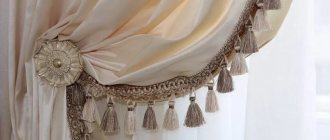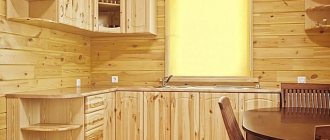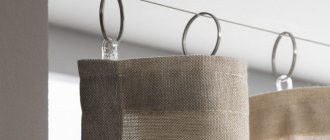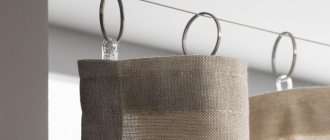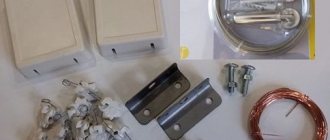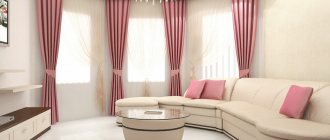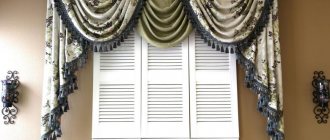How to make a niche for curtains in a suspended ceiling: 5 ways to install a hidden cornice under a curtain
In addition to the traditional fastening of curtain rods to a wall or ceiling, another original option is available with a suspended ceiling - a hidden curtain. This arrangement opens up new design possibilities and makes the room appear higher since the bar is not visible. To do this, you will need to make a suspended ceiling with a niche in which the cornice will be hidden. This way, the curtain mount will be invisible, since the crossbar is recessed into the interceiling space. In this article we will look at how to choose the right cornice and calculate the dimensions of the structure. We will also examine in detail five ways to create a hidden niche in a suspended ceiling.
Photo: Beautiful examples in the interior
PreviousCurtainsDescription of electric curtain rods with automatic drive
Next
CurtainsDescription of cornice for Roman blinds: components, fastening
Recommendations for choosing a cornice
Before purchasing, it is advisable to decide on the approximate design of the curtains. For light curtains, a plastic crossbar is sufficient, but for heavy curtains you will need a durable aluminum or metal curtain rod.
Let’s immediately say that both ceiling and wall models can be installed in a niche, but it is better to give preference to the first option. Such cornices are much more compact and easier to hide behind the tension fabric. Otherwise, you will need to lower the ceiling lower, which will reduce the height of the room.
Curtains are hung in several rows: just tulle, with curtains, or additionally decorated with lambrequins. Depending on the number of curtains, you need to purchase one, two, three or four-row curtain rods. It’s also better to think through this point in advance.
Advice! If you hang a ceiling rail across the entire width of the room, the curtains can be pulled apart on both sides of the window. This will allow more light to enter the room.
Where to choose?
Which cornice to choose depends on the taste and style in which the room is designed. When choosing, cost also plays an important role.
The cost of cornices is influenced by the type of lighting fixtures, the canvas itself, the mounting option, and the number of communication parts on the base ceiling covering.
On sale, cornices come complete with fastenings: screws, dowels, hooks. Depending on the shape and method of installation, the price of curtains for suspended ceilings will average from 350 rubles per square meter in Moscow and the region. A separate cost goes for rounding the cornices - from 260 rubles.
Some ceiling installation companies hold promotions. When ordering a ceiling, you will receive a cornice as a gift.
Which curtains are better for a suspended ceiling is up to you to decide. If you dream of curtains flowing from a height, hidden curtains are your option. If the choice of curtains is not critical, then you can get by with the traditional, external mounting option.
The budget option for curtain rods is plastic. They have a large selection of colors. But, it is better to choose a color that matches the ceiling fabric. The only negative is that heavy curtains cannot withstand them.
Aluminum cornices are similar to plastic structures. They are also light, but quite durable, inexpensive compared to wood. Often the kit includes decorative overlays. Curtain rods are more expensive than plastic ones, but their installation is simple - they do not bend like plastic ones.
The wooden version is expensive. Such curtains look good in apartments with high ceilings. There are options with carvings, ornaments, and drawings. Wooden cornices must fit into the interior, complementing it.
Steel construction is the only option if your curtains are too heavy. Such cornices are often decorated with overlays.
The structure is assembled and the ceiling covering can be installed.
Dimensions and depth of niches for curtains
First of all, the dimensions depend on the chosen cornice and its location in the room. For a lightweight design designed for tulle and thin curtains, a width of a few centimeters is sufficient. For a wider one, on which two or three types of fabric of different weights are hung, you will need at least 10 cm.
Other factors also influence the parameters of a niche for a curtain in a suspended ceiling:
- When determining the width, take into account the dimensions of the window sill and the position of the battery. In order for the curtains to hang evenly, they should not touch the radiator. But too much indentation reduces the usable area of the room. As a rule, the optimal width is 20-25 cm.
- The length most often coincides with the length of the wall. But it may decrease depending on the layout of the room, for example, when the window is located in the corner of the room. The minimum size is slightly wider than the window, at least 10-15 cm on each side, while the curtains should cover the edges of the window sill.
- The depth of the eaves niche depends on the installation method and frame parameters. The minimum distance from the rough ceiling to the suspended ceiling is 5-7 cm. Additionally, it is necessary to take into account the dimensions of the cornice, hooks and curtain tape; they must be completely hidden behind the canvas. In addition, about 8 cm should be added to compensate for the viewing angle, since we are looking at the niche from bottom to top. Thus, the optimal depth is 15-20 cm. It is also important to provide additional space if you plan to install a hidden lighting system.
Note! In a niche that is too deep (for example, in two-level structures, the indentation can reach 40-50 cm) it is inconvenient to attach the crossbar and hang curtains.
Selecting curtains
In this case, ordinary plain curtains made of thick or satin fabric are suitable, which will visually add height to the ceiling, freely falling from under the niche. Thread curtains will perform a similar function.
But you should avoid lambrequins: with a hidden cornice option, they look like scraps of fabric randomly sticking out from under a niche. If the ceiling surface to which the cornice is attached is not wooden, and the console itself is made of durable wood or metal, then you don’t have to worry about using heavy curtains made of thick fabrics.
Imagine you are looking at a window with curtains flowing around it, coming down from nowhere. Agree, quite a stylish and minimalist solution for the room.
The hidden built-in curtain rod in the suspended ceiling looks very stylish and original. And those who are bored with traditional design come to this solution for window openings.
The cornice is mounted together with the ceiling and is part of it
In this design, the cornice is not visible, and the curtains or tulle seem to flow directly from the ceiling. It looks very impressive and extraordinary. You can also install LED lighting on the cornice, which will colorfully highlight the textile composition and bring a special atmosphere to the interior.
In the case of plasterboard, a hidden design involves creating a special niche between the wall and the tension sheet. You need to provide for some nuances in advance: correctly calculate the size of the niche for the free movement of curtains, take into account the width of the battery and window sill, if there are any under the window. Plaster and paint the rough ceiling. Now all this is in the past!
Do you want to move away from classic solutions? Contact us at ProektPro.
calculate the cost of the ceiling
Using this calculator you can calculate the estimated cost of our ceilings on the main fastening systems.
How to make a hidden curtain rod in a suspended ceiling:
Action plan
What is the best way to hang tulle and curtains in a niche?
Stretch ceiling with hidden cornice: design features
choose a coating
installing a suspension system
do the lighting
Action plan
The whole point is to hide the fastening of the curtains. For this we need a suspended ceiling system. It should not be installed along the entire perimeter of the room, but at a certain distance from the window. This is necessary in order to place a hidden curtain rod, which is attached directly to the ceiling, in the free space not occupied by the system.
To achieve the desired result, we have to solve two main problems:
- how and on what to hang curtains to hide their top edge;
- how to create a wall in a suspended structure behind which this edge will be hidden.
What is the best way to hang tulle and curtains in a niche?
Fasteners for curtains must be chosen as compact as possible - after all, they should not be visible. Reliability and price should also be determining factors. Decorative qualities are absolutely not important here.
Reliability depends on the material. For tulle it is better to use plastic products. They are no different in quality from others, but are cheaper. Heavy curtains can withstand either durable plastic or metal. There is a wide selection of wood products, but they are less functional and expensive.
There are four types of curtain rods:
- rod - a horizontal crossbar with a circular cross-section;
- string - unlike the first point, it should not be used under heavy loads;
- baguette - is a decorative strip that hides behind two rails on which fasteners for curtains are placed;
- tire - a profile with the rails mentioned above, but without a decorative strip.
The rod and string can be mounted on a wall or ceiling. We will be satisfied with the second option. Tires are the most compact. They are highly reliable, especially if made of metal.
Compactness is affected by how the canvas is attached. Its top should be as high as possible. Rings equipped with clothespins or hooks are not suitable for us. It is better to “put clothespins and hooks on rails.” The rings can serve us well if the fabric is sewn directly to them, or if they are used to make frames at the top of the curtain - the so-called eyelets, which will be placed on the rod and slide freely along it. The peculiarity of this technique is that the canvas cannot be completely straightened. Waves will always be visible.
Stretch ceiling with hidden cornice: design features
There are several ways to arrange niches using various hanging systems. They are designed in such a way that they can be placed in any part of the room or kitchen, giving the edges and surface any shape you like.
Choosing coverage
One option is a suspended ceiling. It is a plastic or aluminum baguette with a vinyl (PVC) ceiling covering stretched over it. It is attached in two ways:
- using glazing beads - slats that press the canvas to the profile;
- harpoon method - during its production, a profile in the form of a harpoon is welded to the PVC film at the edges, which during installation is inserted into a special fixing groove in the baguette.
The second method, unlike the first, is used by all major manufacturing companies. It is more reliable and costs more.
Installation of ventilation systems- Pipes for internal sewerage
How to choose a window sill?
There are also fabric coverings. Usually they come complete with a fixing profile that works on the principle of clothespins. They are more expensive than vinyl and less versatile. It is not advisable to install them in the kitchen, since the material perfectly absorbs fat, but is difficult to clean and only with the help of a special product. Another distinctive feature is that the fabric does not protect against leaks. If the neighbors above cause a flood, the water will flow down. The coating can only be matte. It cannot be repaired and cannot be used after dismantling.
The only positive quality is the appearance. Vinyl looks a little different. It cannot be said that expensive high-quality vinyl fabric is worse or better, but if fabric is needed, it will only partially replace it.
Installing the suspension system
You can make a hidden niche for a cornice in a suspended ceiling with your own hands. You should start with the markup.
The width of the niche should be in the range from 10 to 20 cm. When calculating it, the space that will be occupied by the folds of folded curtains, pipes, a radiator, a protruding window sill and the complex relief of the walls is taken into account. The greater the width, the more noticeable the overlap. The depth is equal to the height of the hanging system and ranges from 5 to 25 cm. The smaller it is, the better, but sometimes it is necessary to provide lighting, hide wiring, or install a decorative multi-level structure.
An indentation is made from the outer wall with the window. The recess should not be noticeable, but if you stand near the window, it will be impossible not to notice it, so finishing the open part of the ceiling will be necessary. This area should match the color of the entire surface, or be combined with the shade of the curtains. However, you can create an exquisite color mess, guided solely by your sense of taste and inspiration.
Let's consider the most common and most reliable installation option, which uses PVC film and a harpoon fastening method. Baguette profiles can be divided into two main types:
- ceiling - attached to the ceiling and are distinguished by the fact that they have the shape of a corner. The recess into which the harpoon is inserted must always face downwards, so it is located at right angles to the base where the screws are inserted;
- wall - mounted on the wall and have an H-shape. The upper part of the letter “h” is screwed to a vertical surface, and a covering is inserted into the lower part.
Installation of PVC windows- Covering the drain hole with your own hands
- How to lay flexible tiles on the roof?
Usually it is necessary to cover the entire perimeter of the room, so as a rule, the second type is used, which makes it possible to vary the height of the hanging system as desired, limited only by its own dimensions. But what if we have only three sides, and instead of the fourth there is empty space? There are several solutions:
- The base of the vertical side of the niche is made of wooden beams 4x4 or 5x5 cm thick. The thickness varies depending on the height of the entire structure. A ceiling profile is installed on it from the bottom, or a wall profile from the window side. The surface located facing the window does not look the best with this method and requires finishing - putty and painting;
- The base of the vertical side is made of a metal corner 4x4 cm. This method is more reliable, since the block can lead. Over time, even treated wood dries out, cracks, and loses its strength, especially in the window area, where there is the highest humidity and noticeable temperature changes.
- A chipper is attached to a metal corner 4x4 cm from below - a rail with a slightly rounded bottom side. The rounding is necessary so that the PVC film passes over it at the bend, changing its position from horizontal to vertical. The bumper is designed so that the film touches it only in this place. The ceiling profile is mounted on the outer vertical side of the corner so that the part where the harpoon is inserted does not look down, but towards the window and lies close to the ceiling. This design makes it possible to completely close the wall of the niche.
The advantage of a metal corner is not only its reliability, but also the fact that it can be used to make a bend of any shape. This quality can be very important in old houses with bay windows, where the windows are located in a semicircle or in three planes.
Making the backlight
An LED strip or spotlights recessed into the covering are suitable as lighting for a hidden cornice in a suspended ceiling.
If we decide to hide the light source, an LED strip is more suitable for us. Installation is very simple - its back side is covered with double-sided tape. To install it, you just need to cut a piece of the required length and glue it to a clean, dry surface, connecting it to the network via the power supply. Its dimensions are not large and allow it to be placed in a ceiling structure by attaching it to a profile.
There is another rather unusual method - optical fiber. It consumes less energy, does not heat up and is absolutely safe. Fiber optic bundles are connected to the projector, and the luminous ends are brought out into a niche.
Preparation of materials and tools
When arranging niches for hidden cornices, experts who constantly work with plasterboard advise using Volma products, which have a number of advantages that are not available even in expensive finishing materials.
Since plasterboard sheets are light in weight, they can be used in the construction of various ceiling structures, including niches designed to accommodate a built-in cornice.
But the main advantage of this material is its environmental safety, since the raw materials for its production do not contain substances harmful to health. This allows the use of plasterboard sheets for interior finishing work. They need to be cut into strips 15 centimeters wide.
To work with drywall, you should have at your disposal a set of tools that includes:
- tape measure at least three meters long;
- a long metal tape measure, but if you don’t have one, you can use a metal profile;
- stationery or utility knife with replaceable double-sided blades;
- a hacksaw, but in this situation, a poorly sharpened saw for woodwork, which must be narrow, or a hacksaw used for cutting knots is suitable;
- A roughing plane is the only professional tool that you will need to purchase, since with its help you can perform high-quality processing of the edges of the cut area.
There are several options for cutting drywall, among which the most popular are the following:
- uneven cut;
- straight cut;
- double-sided cutout;
- round holes.
To make a niche from gypsum plasterboard, you should master the direct cut method, which is not difficult. To do this, mark the required size on both sides - in this case it is 15 centimeters. Apply a metal ruler to the applied markings and, using a knife, cut through the very top layer of the plasterboard sheet.
When performing this stage, experts advise not to use a pencil when drawing a preliminary line, since the result is an uneven cut. If you deepen the cut several times, the drywall will break along the drawn line, and not in another place.
The sheet of material is then placed on the rib and gently tapped with the knee in the area where the cut is missing. After applying 2-3 blows, you can break the gypsum core strictly along the intended line. Finally, the cardboard that holds the halves of the sheet is cut with a knife. To cut strips that have a large width, use a hacksaw.
The main purpose of cornices
Curtains have several functions in interior design:
How to properly lay a vapor barrier on the ceiling?- Is it possible to glue wallpaper on whitewashed walls?
- Imitation of a brick wall made of gypsum plaster
- Firstly, this is the design. Using a hidden installation, you can achieve elegance, because the curtains will not be visible. It will appear that they are falling from the ceiling without any visible fastenings. Plus, if you add appropriate lighting, you can create a stunning effect. So this will allow you to realize the most daring design solutions.
- Secondly, this is functionality. When hanging curtains on a D-Premium fabric stretch ceiling or Pongs PVC stretch ceiling, you can use a regular ceiling cornice by installing a molding behind the stretch ceiling. Another option is a hidden design.
Advantages of a hidden cornice
A hidden cornice is an ideal option for rooms with low ceilings, because there is no need to allocate a special place for attaching curtains, which will visually reduce the space. In the place where the cornice is installed, you can hide various communications without resorting to a hidden method of additional installation, and you can also install lighting there. Thus, you will save not only time on work, but also significant money.
A hidden cornice will perfectly cover a window sill of any size. This can sometimes be difficult to achieve when using a conventional mount. It does not require time to choose the color and design of the structure, since it will still not be visible, and all the main attention will go only to the curtains. The room will have an atmosphere of limitless space, that is, there will be no defined boundaries of separation.
The cost of a hidden cornice for fabric and PVC stretch ceilings
Installing a hidden cornice does not require large investments, you only pay for practicality. The hidden cornice is installed directly in the niche that is created when installing the stretch ceiling. For certain cornices, the size of the niche is different.
However, there are certain standards: its depth should not be less than 4 cm for light curtains and not less than 20 cm for heavy ones. You purchase a plastic ceiling cornice, installers make a niche in the stretch ceiling and everything is ready. This idea will cost you approximately 400-800 rubles/m2, depending on the complexity of the niche design.
Niche design: creating lighting
It was noted that in addition to the main function, the box allows you to integrate lighting. The organization of additional lighting will look unusual and attractive. The lighting will create the effect that the curtains are airy. To achieve this goal, a strip with LEDs is inserted into a special groove. It can be any color; you don’t have to choose a classic one. This also helps to visually increase the height of the space. Relevant for low rooms.
@remontoffanapa.ru
The box for the curtain rod allows you to hide the auxiliary elements and leave only beautiful curtains for the eyes. There are several methods to implement such a project. One of them can only be performed by professionals. Therefore, if you plan to carry out the work yourself, it is worth taking into account the peculiarities of the methods for creating a recess.
The construction of the box should be planned at the ceiling design stage. Otherwise, it will be impossible to implement such an idea later. A strip of lighting will create an airy effect and add light to the room.
A few ideas on how to hide a cornice behind a suspended ceiling
If you decide to install a cornice behind a suspended ceiling, you should know the various options for its installation.
- Hidden installation. The process of installing a structure invisible to the eye is quite complex. In this case, the cornice is installed in a niche hidden behind the tension shelf. It appears as if the curtains are falling directly from the ceiling.
- Backlight. When installing a cornice, you can consider using lighting. In this case, the work will be carried out slightly differently. The result will be very beautiful and original. LED lamps are located in a specially created plasterboard box.
- Beam. One of the most common options is installation using beams. Here the cornice is attached to a wooden beam, which is mounted on dowels.
- Universal baguette. Alternatively, you can use a baguette.
- The cornice hidden behind the suspended ceiling is shown in the photo above. These pictures show the installation system well. Take a closer look at them to have a clearer understanding of the different installation methods.
Ceiling niche
Regardless of which installation option you choose, in any case you need to create a ceiling niche. Note. When installing a cornice for a suspended ceiling yourself, it is necessary to create a niche during installation of the entire structure.
Work order:
- First you need to mark;
- then install the profiles that form a reliable frame;
- install a mortgage for the cornice;
- stretch the fabric;
- install the cornice.
What you need to know when performing work on installing cornices: take into account
First of all, you need to remember that a suspended ceiling is an easily damaged film, which is extremely difficult to restore in case of careless installation or for any other reason for its damage.
The edges of the cornice, even before installation, need to be wrapped with some kind of fabric to reduce the risk of damage to the stretch ceiling material.
It is necessary to take necessary precautions.
Measures:
- Holes in the film (any!) should be reinforced with special thermal rings to prevent further formation of breaks in the film. If you do not have experience in this painstaking work, it is probably worth inviting specialists from the company to carry out the work.
- During work, you need to be careful when working with any type of tool, constantly remembering the “vulnerability” of the suspended ceiling fabric.
The fact is that the company provides a guarantee for the installation of the canvas, and this is stated in the relevant contract. If in the future the seam of the fabric breaks, or the mounting profile lags behind the wall, then it means that the work on welding the film, as well as the quality of the film, do not correspond to the declared quality, and, of course, fall under the company’s warranty.
If you installed the cornice yourself and damaged the film, then there can be no question of any replacement at the expense of the company, since the fault in this case is only yours. And it’s a completely different matter if the film was damaged by the installers.
About the backlight
As noted above, you can embellish the interior by creating colorful lighting using LED lamps. To do this, use a special profile for PVC suspended ceilings. For D-Premium fabric stretch ceilings, such profiles do not exist; you cannot do without the help of a specialist.
Successful repairs, your navigator in suspended ceilings, NICOMAX COMPANY!
Niche for curtains in a suspended ceiling: design options and fastening methods
When creating an original interior in your apartment or house, you can’t help but pay attention to suspended ceilings. It is through this type of ceiling design that the necessary style and image of the living space is created. Modern technologies have stepped forward, opening up almost unlimited possibilities for the designer’s imagination. If previously it was quite difficult to select cornices for a stretch ceiling, today the situation has changed radically.
Technologies and consumables have appeared that make it possible to equip a room with tension systems with beautiful and stylish curtains. For these purposes, curtains for curtains under suspended ceilings are used, which have different designs and differ in installation methods. Hidden cornices look the most attractive, the installation and design of which arouse genuine interest. Let's look into it in detail. What is needed to properly and correctly install hidden cornices for a tension system.
Niche as an important element of the tension system design
It should be said that curtains, like ceilings, are an important element of the interior. Fabric and material play a key role in creating a certain style, but do not forget how the curtains, tulle or blinds will be attached. With ordinary rooms where there are simple, flat ceiling surfaces, this issue can be resolved quickly and easily. The situation is more complicated in cases where there is a stylish and beautiful stretched fabric in the upper part of the room, and the curtains should emphasize the beauty of the design.
In this case, a suspended ceiling with a niche for curtains solves the problem. This design fully meets the conditions of modern ceiling design and the requirements for the operation of fabric ceilings.
What is a niche? This is a hidden space artificially created in a suspended ceiling or in suspended plasterboard, combined structures. The main function of this element is to disguise the hanging kit for attaching the curtain. This design is most often created near a window opening, but the technical possibility of installing a niche on the ceiling surface in the middle of the room is not excluded. This technical technique involves dividing the internal space into zones. This looks especially good in bedrooms and on open terraces.
The dimensions of the structure are determined by the dimensions of the cornice and the types of curtains. For curtains and curtains made of thick fabric, a recess with a depth of 15 cm will be required, while a structure with a depth of 4-5 cm will be sufficient for tulle and lambrequins. It is permissible to create a recess in stretch ceilings with a depth of 25-30 cm when it comes to multi-layer heavy drapery.
Note: curtains or drapes can be ordinary, attached to the curtain rods using rings or plastic hooks. Curtains with scallops are sometimes used. In such cases, a special fastening is used - eyelets.
Functionally, the niche performs two tasks.
The first and most basic is decorative. Thanks to this technical solution, it becomes possible to style the room in one key. Those. curtains and curtains descend directly from the ceiling, visually increasing the interior space. The second problem that the presence of a recess in the ceilings solves is the convenient use of hanging materials. Curtains, tulle curtains can be changed over a certain period of time, while the suspended ceiling remains untouched, safe and sound. In addition, the presence of a recess on the ceiling surface allows you to improve the aesthetic perception of the upper part of the room by installing decorative lighting in the niche.
How to hide hangers with a ceiling plinth: photos, examples
You can cover some shortcomings in wall decoration and hide the suspension using a regular ceiling plinth. However, this requires basic skills in installing skirting boards on the ceiling. First you need to choose the baseboard itself. It should be wide and have a flat surface on top so that it can be fixed to the ceiling.
If the curtains are suspended from a ceiling cornice, it is quite easy to create the illusion of a hidden cornice using an ordinary baseboard
Products made from polyurethane foam, polystyrene foam or duropolymer are suitable for this purpose.
Note! Ceiling plinth plays an important decorative role in the interior. Its design, color, and ornament must be in harmony with the overall style of the room.
In order for the baseboard to hold securely, you will need to install a vertical base in the form of a plank.
The design must completely hide the curtain fastening elements
Next, you should purchase glue for attaching polyurethane products. It must be applied to the baseboard and the canvas pressed tightly against the ceiling. The glue sets quickly enough to securely fix the product. The plinth is attached at a short distance from the cornice. The same skirting boards should be placed around the entire perimeter of the room. Then its design will look solid and harmonious.
You can see photo examples of such methods of masking suspensions below.
Methods for equipping a niche for a tension system
A niche for curtains in a suspended ceiling is not a complex element in its design. However, to create it you will need a lot of experience and skills. If you wish, you can decide to work independently, provided that all the subtleties and nuances are observed. You need to know where to attach the structural elements and what fittings to use for installation.
Important! The marking and installation of niche structural elements is carried out at a preliminary stage, when the canvas for the ceiling part is in a folded state. Alterations already in the process of stretching the fabric or film can lead to the main surface going in waves and folds appearing on it.
What the main work looks like in this case:
- the recess is made using a metal or plastic profile, which is attached with dowels directly to the rough ceiling surface;
- a metal corner or wooden beam is fixed in different places, while at the same time constantly checking the horizontality of the structure;
- for those cases where lighting equipment is planned, profiles with a special shelf are used.
- profiles or baguettes in the place where the niche is planned are attached first;
- stretching the film or canvas is done only when the finishing of the niche is completed.
For reference: the bottom of the niche is usually plastered or covered with sheets of plasterboard. Accordingly, the upper corners in the niche must have the correct shape so that there is somewhere to install a glazing bead or wedge profile to fix the edge of the canvas.
The main parts and structural elements are indicated in the figure, which allows you to get a fairly complete idea of what you have to deal with. The presented set of equipment and devices is standard for the equipment of recesses in tensioned fabrics.
To work you will need:
- aluminum corner 40x40mm;
- bumper;
- ceiling and PVC plinth;
- harpoon.
This design is designed for the most rich equipment of the ceiling surface, including the installation of spotlights and hidden lighting.
Another option for installing the recess looks more affordable and simpler to implement. This requires a minimum of parts and connections. Instead of expensive metal components, you can use wooden blocks and plastic harpoon baguettes.
The simplest option is based on the use of a wooden block. The dimensions of the timber can be 40x40 or 50x50mm. Ceiling and wall moldings are used to fasten the canvas.
Complex design options
For more complex ceiling design options, various options are used for installing the cornice in a niche, which can have a curved shape. For example, a niche for cornices with a bend.
In this case, instead of wooden blocks, a U-shaped metal profile or a stacked structure with metal corners and a bumper is used. With this design, you can do without attaching a baguette. The recess for the harpoon is created in advance.
Using hidden metal profiles, you can create niches with a bend for complex multi-row hidden cornices. Curved areas are of some interest in terms of design excellence. Another complex option is a niche in a suspended ceiling, which is mainly designed for installing hidden lighting. Here, another element is added to the niche design - a baguette with a recess, especially for laying the LED strip.
Everything else is done using the same technology that was described above, in a traditional, standard or budget version.
Recommendations for equipment and installation of niches in suspended ceilings
The first thing you need to pay attention to when planning the installation of hidden curtain rods is what type of curtain will be used in the future. Both light materials (tulle, gauze, chiffon and satin) and heavy fabrics (gabardine, lurex, velor and velvet) are equally suitable for stretch ceilings.
Accordingly, for each type of curtains, a different type of frame is selected - a plastic or metal profile, a pipe or multi-row pencil cases. To implement the practical part, try to take into account the following aspects:
- Curtains for suspended ceilings look best in large and deep niches that can be equipped in tension systems. Typically, this design option is used in large and spacious rooms, where there are no critical comments on the height of the room and the area of the ceiling.
- The width of the niche varies in the range of 10-25 cm, depending on what type of fabric is used for the curtain and how many rows there will be.
- Do not forget to take into account the width of the window sill when determining the width of the niche. Together with heating radiators, the window sill usually protrudes 10 mm from the wall. Curtains should not lie close to radiators.
- It is better to make a niche across the entire width of the room, this will make it easier to install a suspended ceiling and this design will be convenient for installing and dismantling cornices.
Installing a plasterboard box
To install such a structure you must purchase:
- metal ceiling profile measuring 27x60x3000 centimeters;
- guide profiles for curtains on the ceiling, preferably made of aluminum, but you can also use wooden products measuring 28x27x3000 centimeters;
- plasterboard sheets;
- screwdriver or drill;
- screws or staples.
The sequence of actions when creating a niche for a hidden cornice is as follows:
- First, measure the distance from the wall in which the window opening is located to the edge of the window sill or heating radiator in the case where the battery protrudes beyond the window sill. Next, 10 centimeters are added to the resulting value, which is the size of the allowance that is necessary for the curtains to move freely in the niche space. Most often, you need this distance to be at least 15 centimeters, since this will make it easier to install the cornice in the future, but it should not exceed 20 centimeters.
- Then, using a paint cord, mark a line and draw it parallel to the wall, which will become the edge of the niche.
- Using a screwdriver or drill, guide profiles are attached according to the drawn line so that the gap between the dowels is at least 60 centimeters.
- To assemble the side parts of the box, pre-cut plasterboard strips are screwed to the guide profiles. In this case, the fixation step must be at least 15 centimeters.
- The perimeter is marked on the end sides of the future box and the structure is similarly secured with self-tapping screws. The profile must be placed in the direction of the walls.
- Using a hacksaw, strips of drywall are cut relative to the profile, which simultaneously become the sides of the niche.
- Perform end processing using a plane.
- Using the ceiling profile, they begin to assemble the sheathing at intervals of at least 40 centimeters.
Drywall is cut according to the width of the niche and the bottom of the box is sewn with this material. The side walls can be made of transparent plastic or glass. Designers suggest making the edges of the box not only smooth, but also curly, looking like waves or all kinds of geometric shapes. As for such a parameter as the width of the box, it can be different, depending on the height and size of the room.
conclusions
Stretch ceilings can now be made even in the most daring version. The presence of all kinds of devices and accessories allows you to create the most intricate types of ceiling designs, one of which is curtains flowing from above. The niche needed to install hidden cornices is quite simple to make. The main thing is to comply with the necessary conditions and technology requirements. Finally, remember the following main aspects that you may need in your work:
- A niche in suspended ceilings is made only when installing hidden cornices
- Acceptable parameters for the excavation depth are minimum 4 cm, maximum 25-30 cm.
- The maximum permissible parameters for the width of the recess in suspended ceilings are 10-25 cm.
- The niche can have a simple shape and design or be made to suit the complex configuration of the ceiling part
- Marking and installation of fastening devices is carried out before the start of the main work on stretching the fabric
Ceiling hidden curtain rods
- Features and Benefits
- Design Features
- Materials
- Installation features
- Practical recommendations
- Beautiful examples in the interior
The main task of ceiling cornices is to be able to securely fix curtains. And only then the question of aesthetics arises. But the standard option does not always fit into the interior style. Especially when it comes to modern design solutions. Therefore, the desire to remove the cornice but leave its functionality is understandable.
Hidden structures look very beautiful indoors. Visually raising the ceilings, they create a harmonious and impressive interior, drawing all attention to massive and weightless fabrics and decorative elements. The curtains seem to flow directly from the ceiling. By expanding the space, ceiling cornices increase the area of the room, which is a definite plus for miniature apartments.
What are hidden ceiling cornices, what are the key features and how to choose and install correctly - we will tell you in the article.
Features of arranging a niche for a cornice
Drywall is a modern material that has undeniable advantages and is used in the implementation of various design solutions, including the installation of a special cornice.
However, the design using gypsum plasterboard has little strength and is unable to withstand heavy weight loads in the form of heavy window curtains. The solution to this problem is to create sheathing for ceiling niches to attach hidden cornices.
Features and Benefits
Often, the desire to hide the cornice arises among owners of suspended ceilings, when they do not want their eyes to cling to the metal pipe above the window instead of a smooth coating and shiny fabric. At the same time, in a well-thought-out interior, at first glance it remains unclear how the curtains falling from the ceiling are attached.
The main advantage of built-in curtain rods is the ability to be used in non-standard rooms with an unusual window shape. At the same time, the design itself can be adjusted to any features and repeat a U-shaped, curved and semicircular line.
Why choose a hidden cornice? For low ceilings, the use of a regular rough cornice is unacceptable. One element can visually steal most of the room. For such apartments, a hidden curtain rod is perhaps the only preferable option that can make the room more spacious and wider:
- Thick curtains across the entire width of the wall look very laconic, beautiful and modern.
- Hidden designs are great for rooms with suspended ceilings. The proximity of a hidden cornice and a vulnerable ceiling covering is absolutely safe and will not cause damage to the film.
- Vertical folds of curtains flowing down without any support look incredibly beautiful and expand the space of the room.
- For owners of wide window sills, built-in cornices are an excellent way out. With such a feature of the window, choosing a suitable option is quite difficult. And with a hidden design, you can hang any curtains, regardless of the window sill.
- Installing a built-in cornice yourself is no more difficult than a regular one.
An invisible cornice fits perfectly into any interior and is a practical and universal solution:
- In an additional ceiling niche in front of the wall, you can hide wires, install an Internet line, provide ventilation, or decorate the structure with additional lighting.
- Color, texture, elegance of fabric and decor take first place in the interior of the room.
- Expands the field of work for design ideas and solutions.
- Hidden curtain rods are cheaper than standard open-form models.
